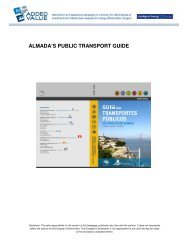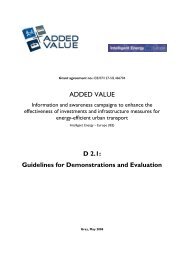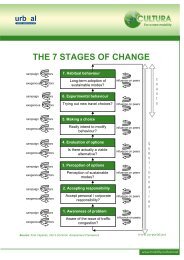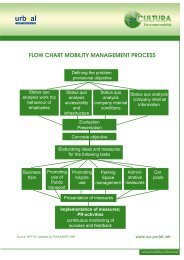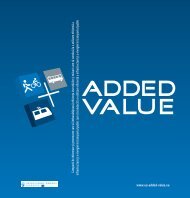SUMO - Eltis
SUMO - Eltis
SUMO - Eltis
You also want an ePaper? Increase the reach of your titles
YUMPU automatically turns print PDFs into web optimized ePapers that Google loves.
Background<br />
Services<br />
Option offered<br />
Effects<br />
<strong>SUMO</strong> analysis levels<br />
LEVEL INDICATORS<br />
Y<br />
P<br />
A<br />
B<br />
C<br />
D<br />
E<br />
F<br />
G<br />
H<br />
I<br />
External factors<br />
Person-related<br />
factors<br />
Useful<br />
achievements<br />
Awareness of<br />
mobility service<br />
Degree of use of<br />
mobility service<br />
Satisfaction with<br />
the mobility service<br />
Acceptance of the<br />
offer<br />
Experimental<br />
individual<br />
behaviour<br />
Satisfaction with<br />
the offer<br />
Permanent<br />
individual travel<br />
behaviour<br />
System impact<br />
*) Can be identified using focus groups of drivers.<br />
– Legislation, fines<br />
– Urban or rural driving<br />
– Deliveries with regular stops or long-distance driving<br />
– Gender<br />
– Age<br />
– Number of meetings held with management<br />
– Number of occasions aimed at increasing driver interest<br />
in road safety aspects of their working environment<br />
Hardly relevant to measure separately, go directly to next level.<br />
– Number (percentage) of drivers that attended the course<br />
– Number (percentage) of employees that think the course<br />
was good<br />
In this case, the analysis level does not contribute anything and<br />
can be omitted.<br />
Possible indicators:<br />
– Number (percentage) of drivers that say they are<br />
planning to follow a policy that includes seat belt use<br />
– Number (percentage) of drivers that in a questionnaire say<br />
they always use a seat belt<br />
– Random checks to measure the actual level of seat belt use<br />
– Measurements before and after the course.<br />
In this case, the analysis level does not contribute anything and<br />
can be omitted.<br />
Possible indicators:<br />
– Comments* on how the use of seat belts is working<br />
– Number (percentage) of drivers that in a questionnaire say<br />
they always use a seat belt<br />
– Random checks to measure the actual level of seat belt use<br />
Measurements are carried out 12 months after the course<br />
National cause and effect relationships exist between seat belt<br />
use and the outcome of accidents. It is hardly possible to<br />
measure system effects at an individual company. At larger<br />
companies it may be possible to use insurance statistics or other<br />
accident and injury reports.<br />
sumo – Appendix 41<br />
2<br />
EXAMPLE



